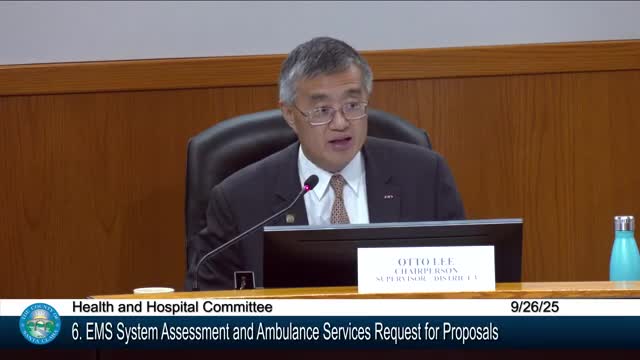County updates ambulance RFP timeline, unveils Nurse Navigator pilot results and CAD improvements
September 27, 2025 | Santa Clara County, California
This article was created by AI summarizing key points discussed. AI makes mistakes, so for full details and context, please refer to the video of the full meeting. Please report any errors so we can fix them. Report an error »

Santa Clara County EMS staff told the Health and Hospital Committee they are proceeding with a system assessment and a multiyear Request for Proposals (RFP) for ambulance services while piloting programs to reduce low‑acuity 911 transports.
EMS Director Nick Clay said the county’s consultant (AP Triton) has completed primary data collection and will run three community engagement tracks: a field provider survey, a stakeholder survey for local leaders and advocacy groups, and a broad public survey. Clay said a draft assessment will be available to the agency by year‑end and then publicly released thereafter.
On the ambulance RFP timeline, Clay said the county expects to submit the draft to the state for review in mid‑2026, with a state review period that could take up to six months, then release an RFP in early 2027, and complete contract negotiations and presentation by 2027. If a new provider is selected, a one‑year ramp‑up would aim for service start by Jan. 1, 2029.
Clay described two operational priorities that will shape the RFP: (1) incorporation of basic life support (BLS) into a stratified delivery model instead of an ALS‑only design, and (2) new statutory terms the state now requires counties to include. Committee members and staff flagged uncertainty because the state has not finalized many of its long‑overdue regulations for ambulance systems; county staff said the regulatory vacuum has driven litigation in other jurisdictions and complicates planning.
Clay also reviewed the Nurse Navigator pilot, which began Nov. 13 and targeted low‑acuity 911 calls. The pilot covered a small area and recorded 166 nurse navigation dispositions (about 1% of calls in the pilot area). Clay reported that the pilot saved an estimated $750,000 in health‑care costs for that pilot sample and suggested that a 1% county‑wide success rate could translate to roughly $7,000,000 in avoided patient health‑care costs; he and staff stressed this is an estimate based on local cost assumptions and that higher diversion rates would yield larger savings. Clay described plans to centralize training, expand urgent‑care and clinic referral networks, and allow in‑field referrals by all providers as of Jan. 1.
The EMS agency said it will deploy an upgraded CAD overlay system (referred to as Marvelous) in early November to improve dynamic ambulance movement, unit recommendations, and data access. The director said the previous move‑up tool showed units as covering an area while en route and produced inefficient placements; Marvelous is expected to allow more precise ambulance positioning and improved availability.
The committee voted to receive the EMS system assessment and RFP update and the annual and quality reports (items 6, 7 and 8). Members asked the agency to engage unions, fire departments, and city leaders in the assessment and to consult the county’s intergovernmental relations team about the state regulatory gaps.
EMS Director Nick Clay said the county’s consultant (AP Triton) has completed primary data collection and will run three community engagement tracks: a field provider survey, a stakeholder survey for local leaders and advocacy groups, and a broad public survey. Clay said a draft assessment will be available to the agency by year‑end and then publicly released thereafter.
On the ambulance RFP timeline, Clay said the county expects to submit the draft to the state for review in mid‑2026, with a state review period that could take up to six months, then release an RFP in early 2027, and complete contract negotiations and presentation by 2027. If a new provider is selected, a one‑year ramp‑up would aim for service start by Jan. 1, 2029.
Clay described two operational priorities that will shape the RFP: (1) incorporation of basic life support (BLS) into a stratified delivery model instead of an ALS‑only design, and (2) new statutory terms the state now requires counties to include. Committee members and staff flagged uncertainty because the state has not finalized many of its long‑overdue regulations for ambulance systems; county staff said the regulatory vacuum has driven litigation in other jurisdictions and complicates planning.
Clay also reviewed the Nurse Navigator pilot, which began Nov. 13 and targeted low‑acuity 911 calls. The pilot covered a small area and recorded 166 nurse navigation dispositions (about 1% of calls in the pilot area). Clay reported that the pilot saved an estimated $750,000 in health‑care costs for that pilot sample and suggested that a 1% county‑wide success rate could translate to roughly $7,000,000 in avoided patient health‑care costs; he and staff stressed this is an estimate based on local cost assumptions and that higher diversion rates would yield larger savings. Clay described plans to centralize training, expand urgent‑care and clinic referral networks, and allow in‑field referrals by all providers as of Jan. 1.
The EMS agency said it will deploy an upgraded CAD overlay system (referred to as Marvelous) in early November to improve dynamic ambulance movement, unit recommendations, and data access. The director said the previous move‑up tool showed units as covering an area while en route and produced inefficient placements; Marvelous is expected to allow more precise ambulance positioning and improved availability.
The committee voted to receive the EMS system assessment and RFP update and the annual and quality reports (items 6, 7 and 8). Members asked the agency to engage unions, fire departments, and city leaders in the assessment and to consult the county’s intergovernmental relations team about the state regulatory gaps.
View full meeting
This article is based on a recent meeting—watch the full video and explore the complete transcript for deeper insights into the discussion.
View full meeting
